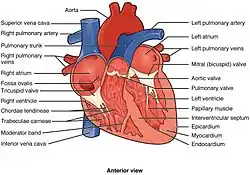Trabeculae carneae
| Trabeculae carneae | |
|---|---|
 | |
| Details | |
| Identifiers | |
| Latin | trabeculae carneae cordis |
| TA98 | A12.1.00.020 A12.1.02.021 A12.1.04.011 |
| TA2 | 4049, 4071, 4024, 4056 |
| FMA | 76525 |
| Anatomical terminology | |
The trabeculae carneae (columnae carneae, or meaty ridges), are rounded or irregular muscular columns which project from the inner surface of the right and left ventricle of the heart.[1] These are different from the pectinate muscles, which are present in the atria of the heart.
Types
There are 2 kinds:
- Some are attached along their entire length on one side and merely form prominent ridges,
- Others are fixed at their extremities but free in the middle, as in the moderator band in the right ventricle, or the papillary muscles that holds chordae tendinae, which are connected to cusps of valves to control flow of blood into the heart
Function
Trabeculae lie at the interface between intracardiac flow and the compact myocardium. Their fractal branching pattern helps to maintain cardiac performance in both healthy and failing hearts by increasing contractility and stroke work.[2] Trabecular morphology is also important to intraventricular conduction, suggesting these complex structures are involved in cardiac electrophysiology as well as mechanical function.[3] A condensation of trabecular fibres forms the moderator band which carries the right branch of the bundle of His.
The trabeculae carneae also serve a function similar to that of papillary muscles in that their contraction pulls on the chordae tendineae, preventing inversion of the mitral (bicuspid) and tricuspid valves towards the atrial chambers, which would lead to subsequent leakage of the blood into the atria. By this action on the atrioventricular valves, backflow of the blood from the ventricles into the atria is prevented.
See also
References
![]() This article incorporates text in the public domain from page 532 of the 20th edition of Gray's Anatomy (1918)
This article incorporates text in the public domain from page 532 of the 20th edition of Gray's Anatomy (1918)
- ↑ Moore, K.L., & Agur, A.M. (2007). Essential Clinical Anatomy: Third Edition. Baltimore: Lippincott Williams & Wilkins. 90-94. ISBN 978-0-7817-6274-8
- ↑ Meyer HV, Dawes TJW, Serrani M, Bai W, Tokarczuk P, Cai J; et al. (2020). "Genetic and functional insights into the fractal structure of the heart". Nature. 584 (7822): 589–594. doi:10.1038/s41586-020-2635-8. PMC 7116759. PMID 32814899.
{{cite journal}}: CS1 maint: multiple names: authors list (link) - ↑ Olejníčková V, Šaňková B, Sedmera D, Janáček J (2018). "Trabecular Architecture Determines Impulse Propagation Through the Early Embryonic Mouse Heart". Front Physiol. 9: 1876. doi:10.3389/fphys.2018.01876. PMC 6331446. PMID 30670981.
{{cite journal}}: CS1 maint: multiple names: authors list (link)
External links
- thoraxlesson4 at The Anatomy Lesson by Wesley Norman (Georgetown University) (heartinternalstructures - "TC" on diagram)
- Diagram at University of Edinburgh—fourth and fifth diagrams from top